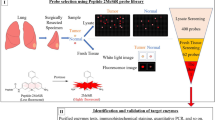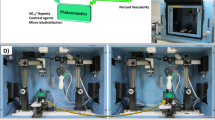Abstract
Companion diagnostics (CDx) are powerful tests that can provide physicians with crucial biomarker information that can improve treatment outcomes by matching therapies to patients. Here, we report a photoacoustic imaging-based CDx (PACDx) for the selective detection of elevated glutathione (GSH) in a lung cancer model. GSH is abundant in most cells, so we adopted a physical organic chemistry approach to precisely tune the reactivity to distinguish between normal and pathological states. To evaluate the efficacy of PACDx in vivo, we designed a blind study where photoacoustic imaging was used to identify mice bearing lung xenografts. We also employed PACDx in orthotopic lung cancer and liver metastasis models to image GSH. In addition, we designed a matching prodrug, PARx, that uses the same SNAr chemistry to release a chemotherapeutic with an integrated PA readout. Studies demonstrate that PARx can inhibit tumour growth without off-target toxicity in a lung cancer xenograft model.

This is a preview of subscription content, access via your institution
Access options
Access Nature and 54 other Nature Portfolio journals
Get Nature+, our best-value online-access subscription
$29.99 / 30 days
cancel any time
Subscribe to this journal
Receive 12 print issues and online access
$259.00 per year
only $21.58 per issue
Buy this article
- Purchase on Springer Link
- Instant access to full article PDF
Prices may be subject to local taxes which are calculated during checkout






Similar content being viewed by others
Data availability
All data are available within the Article and its Supplementary Information. Alternatively, data are available upon request from the corresponding author.
References
Siegel, R. L., Miller, K. D. & Jemal, A. Cancer statistics, 2020. CA Cancer J. Clin. 70, 7–30 (2020).
Dracopoli, N. C. & Boguski, M. S. The evolution of oncology companion diagnostics from signal transduction to immuno-oncology. Trends Pharmacol. Sci. 38, 41–54 (2017).
Agarwal, A., Ressler, D. & Snyder, G. The current and future state of companion diagnostics. Pharmgenomics Pers. Med. 8, 99–110 (2015).
Wang, L. V. & Hu, S. Photoacoustic tomography: in vivo imaging from organelles to organs. Science 335, 1458–1462 (2012).
Heijblom, M. et al. Photoacoustic image patterns of breast carcinoma and comparisons with magnetic resonance imaging and vascular stained histopathology. Sci. Rep. 5, 11778 (2015).
Yang, M. et al. Photoacoustic/ultrasound dual imaging of human thyroid cancers: an initial clinical study. Biomed. Opt. Express 8, 3449–3457 (2017).
Jo, J. et al. A functional study of human inflammatory arthritis using photoacoustic imaging. Sci. Rep. 7, 15026 (2017).
Liu, Y., Zhang, L., Li, S., Han, X. & Yuan, Z. Imaging molecular signatures for clinical detection of scleroderma in the hand by multispectral photoacoustic elastic tomography. J. Biophoton. 11, e201700267 (2018).
Reinhardt, C. J. & Chan, J. Development of photoacoustic probes for in vivo molecular imaging. Biochemistry 57, 194–199 (2018).
Knox, H. J. & Chan, J. Acoustogenic probes: a new frontier in photoacoustic imaging. Acc. Chem. Res. 51, 2897–2905 (2018).
Li, H., Zhang, P., Smaga, L. P., Hoffman, R. A. & Chan, J. Photoacoustic probes for ratiometric imaging of copper(II). J. Am. Chem. Soc. 137, 15628–15631 (2015).
Mishra, A., Jiang, Y., Roberts, S., Ntziachristos, V. & Westmeyer, G. G. Near-infrared photoacoustic imaging probe responsive to calcium. Anal. Chem. 88, 10785–10789 (2016).
Roberts, S. et al. Calcium sensor for photoacoustic imaging. J. Am. Chem. Soc. 140, 2718–2721 (2018).
Wang, S. et al. Activatable small-molecule photoacoustic probes that cross the blood–brain barrier for visualization of copper(II) in mice with Alzheimer’s disease. Angew. Chem. Int. Ed. 58, 12415–12419 (2019).
Lucero, M. Y. et al. Activity-based photoacoustic probe for biopsy-free assessment of copper in murine models of Wilson’s disease and liver metastasis. Proc. Natl Acad. Sci. USA 118, e2106943118 (2021).
Knox, H. J. et al. A bioreducible N-oxide-based probe for photoacoustic imaging of hypoxia. Nat. Commun. 8, 1794 (2017).
Knox, H. J., Kim, T. W., Zhu, Z. & Chan, J. Photophysical tuning of N-oxide-based probes enables ratiometric photoacoustic imaging of tumor hypoxia. ACS Chem. Biol. 13, 1838–1843 (2018).
Chen, M. et al. Simultaneous photoacoustic imaging of intravascular and tissue oxygenation. Opt. Lett. 44, 3773–3776 (2019).
Zhou, E. Y., Knox, H. J., Liu, C., Zhao, W. & Chan, J. A conformationally restricted aza-BODIPY platform for stimulus-responsive probes with enhanced photoacoustic properties. J. Am. Chem. Soc. 141, 17601–17609 (2019).
Gardner, S. H. et al. A general approach to convert hemicyanine dyes into highly optimized photoacoustic scaffolds for analyte sensing. Angew. Chem. Int. Ed. 60, 18860–18866 (2021).
Yin, L. et al. Quantitatively visualizing tumor-related protease activity in vivo using a ratiometric photoacoustic probe. J. Am. Chem. Soc. 141, 3265–3273 (2019).
Levi, J. et al. Design, synthesis and imaging of an activatable photoacoustic probe. J. Am. Chem. Soc. 132, 11264–11269 (2010).
Reinhardt, C. J., Zhou, E. Y., Jorgensen, M. D., Partipilo, G. & Chan, J. A ratiometric acoustogenic probe for in vivo imaging of endogenous nitric oxide. J. Am. Chem. Soc. 140, 1011–1018 (2018).
Reinhardt, C. J., Xu, R. & Chan, J. Nitric oxide imaging in cancer enabled by steric relaxation of a photoacoustic probe platform. Chem. Sci. 11, 1587–1592 (2020).
Lucero, M. Y. et al. Development of NIR-II photoacoustic probes tailored for deep-tissue sensing of nitric oxide. J. Am. Chem. Soc. 143, 7196–7202 (2021).
Chen, Z. et al. An optical/photoacoustic dual-modality probe: ratiometric in/ex vivo imaging for stimulated H2S upregulation in mice. J. Am. Chem. Soc. 141, 17973–17977 (2019).
Forman, H. J., Zhang, H. & Rinna, A. Glutathione: overview of its protective roles, measurement and biosynthesis. Mol. Aspects Med. 30, 1–12 (2009).
Balendiran, G. K., Dabur, R. & Fraser, D. The role of glutathione in cancer. Cell Biochem. Funct. 22, 343–352 (2004).
Gamcsik, M. P., Kasibhatla, M. S., Teeter, S. D. & Colvin, O. M. Glutathione levels in human tumors. Biomarkers 17, 671–691 (2012).
Russo, A., DeGraff, W., Friedman, N. & Mitchell, J. B. Selective modulation of glutathione levels in human normal versus tumor cells and subsequent differential response to chemotherapy drugs. Cancer Res. 46, 2845–2848 (1986).
Giustarini, D. et al. Glutathione, glutathione disulfide and S-glutathionylated proteins in cell cultures. Free Radical Biol. Med. 89, 972–981 (2015).
Estrela, J. M., Ortega, A. & Obrador, E. Glutathione in cancer biology and therapy. Crit. Rev. Clin. Lab. Sci. 43, 143–181 (2006).
Zhang, J. et al. Synthesis and characterization of a series of highly fluorogenic substrates for glutathione transferases, a general strategy. J. Am. Chem. Soc. 133, 14109–14119 (2011).
Shibata, A. et al. Fluorogenic probes using 4-substituted-2-nitrobenzenesulfonyl derivatives as caging groups for the analysis of human glutathione transferase catalyzed reactions. Analyst 138, 7326–7330 (2013).
Lee, M. H. et al. Disulfide-cleavage-triggered chemosensors and their biological applications. Chem. Rev. 113, 5071–5109 (2013).
Maeda, H. et al. 2,4-Dinitrobenzenesulfonyl fluoresceins as fluorescent alternatives to Ellman’s reagent in thiol-quantification enzyme assays. Angew. Chem. Int. Ed. 44, 2922–2925 (2005).
Hansch, C., Leo, A. & Taft, R. W. A survey of Hammett substituent constants and resonance and field parameters. Chem. Rev. 91, 165–195 (1991).
van Iersel, M. L. P. S. et al. Inhibition of glutathione S-transferase activity in human melanoma cells by α,β-unsaturated carbonyl derivatives. Effects of acrolein, cinnamaldehyde, citral, crotonaldehyde, curcumin, ethacrynic acid and trans-2-hexenal. Chem. Biol. Interact. 102, 117–132 (1996).
Rahman, I., Kode, A. & Biswas, S. K. Assay for quantitative determination of glutathione and glutathione disulfide levels using enzymatic recycling method. Nat. Protoc. 1, 3159–3165 (2006).
Manegold, C. Gemcitabine (Gemzar®) in non-small cell lung cancer. Expert Rev. Anticancer Therapy 4, 345–360 (2004).
Hayashi, H., Kurata, T. & Nakagawa, K. Gemcitabine: efficacy in the treatment of advanced stage nonsquamous non-small cell lung cancer. Clin. Med. Insights Oncol. 5, 177–184 (2011).
Toschi, L., Finocchiaro, G., Bartolini, S., Gioia, V. & Cappuzzo, F. Role of gemcitabine in cancer therapy. Future Oncol. 1, 7–17 (2005).
He, M., Xuehong, C. & Yepeng, L. Small molecular gemcitabine prodrugs for cancer therapy. Curr. Med. Chem. 26, 5562–5582 (2019).
Ullman-Cullere, M. H. & Foltz, C. J. Body condition scoring: a rapid and accurate method for assessing health status in mice. Lab. Anim. Sci. 49, 319–323 (1999).
Milovanovic, I. S., Stjepanovic, M. & Mitrovic, D. Distribution patterns of the metastases of the lung carcinoma in relation to histological type of the primary tumor: an autopsy study. Ann. Thorac. Med. 12, 191–198 (2017).
Glutathione (GSH) Probes (Ursa Bioscience, 2013); https://ursabioscience.com/technology/gsh-probes
Jiang, X. et al. Quantitative real-time imaging of glutathione. Nat. Commun. 8, 16087 (2017).
Zhou, H. et al. Intracellular endogenous glutathione detection and imaging by a simple and sensitive spectroscopic off–on probe. Analyst 143, 2390–2396 (2018).
Guo, R. et al. GSH activated biotin-tagged near-infrared probe for efficient cancer imaging. Theranostics 9, 3515–3525 (2019).
Zou, Y. et al. Bioimaging of glutathione with a two-photon fluorescent probe and its potential application for surgery guide in laryngeal cancer. ACS Sens. 5, 242–249 (2020).
Acknowledgements
This work was supported by the National Institutes of Health (R35GM133581). M.Y.L acknowledges the Alfred P. Sloan Foundation for financial support. Major funding for the 500-MHz Bruker CryoProbeTM was provided by the Roy J. Carver Charitable Trust (Muscatine, Iowa; grant no. 15-4521) to the School of Chemical Sciences NMR Lab. The Q-TOF Ultima mass spectrometer was purchased in part with a grant from the National Science Foundation, Division of Biological Infrastructure (DBI-0100085). We also acknowledge the Core Facilities at the Carl R. Woese Institute for Genomic Biology for access to the Zeiss LSM 700 confocal microscope and corresponding software. We also acknowledge I. Dobrucka and the Molecular Imaging Laboratory at the Beckman Institute for use of the IVIS imaging system. M.Y.L. thanks H. Knox for initial animal training and assistance with the NanoZoomer. We thank T. Bearrood and C. Anorma for assistance with initial confocal imaging experiments, L. Akin for aid with mass spectrometry experiments, S. Anakk and A. Dean for help with interpreting results from H&E staining experiments, N. Herndon and J. Xu for help with generating the orthotopic lung cancer and liver metastasis models, S. Gardner for providing 4T1 tumour models, J. Sarol and A. Kaur from Biostatistics, Epidemiology, & Research Design at the Interdisciplinary Health Sciences Institute (UIUC) for aid in statistical analysis, and A. Bennet for helpful discussions.
Author information
Authors and Affiliations
Contributions
M.Y.L. performed all experiments in this study that include chemical synthesis, in vitro characterization, cellular studies, tumour model studies, in vivo imaging and sample preparation for ex vivo analysis. J.C. assisted with the blinded animal study. M.Y.L. and J.C. analysed the data and prepared the manuscript. J.C. conceived the project, with intellectual contributions from M.Y.L.
Corresponding author
Ethics declarations
Competing interests
The authors declare no competing interests.
Additional information
Peer review information Nature Chemistry thanks Junjie Yao, Deju Ye and the other, anonymous, reviewer(s) for their contribution to the peer review of this work.
Publisher’s note Springer Nature remains neutral with regard to jurisdictional claims in published maps and institutional affiliations.
Supplementary information
Supplementary Information
Supplementary Figs. 1–34, Tables 1 and 2 and NMR spectra 2–21.
Rights and permissions
About this article
Cite this article
Lucero, M.Y., Chan, J. Photoacoustic imaging of elevated glutathione in models of lung cancer for companion diagnostic applications. Nat. Chem. 13, 1248–1256 (2021). https://doi.org/10.1038/s41557-021-00804-0
Received:
Accepted:
Published:
Issue Date:
DOI: https://doi.org/10.1038/s41557-021-00804-0
This article is cited by
-
Kinetically and thermodynamically controlled one-pot growth of gold nanoshells with NIR-II absorption for multimodal imaging-guided photothermal therapy
Journal of Nanobiotechnology (2023)
-
Controlled sequential in situ self-assembly and disassembly of a fluorogenic cisplatin prodrug for cancer theranostics
Nature Communications (2023)
-
Cucurbit[8]uril-based water-dispersible assemblies with enhanced optoacoustic performance for multispectral optoacoustic imaging
Nature Communications (2023)
-
Molecular imaging: design mechanism and bioapplications
Science China Chemistry (2023)
-
Noncovalent conformational lock-based molecular engineering improves NIR-II photoacoustic/photothermal performance of semiconducting polymer nanoparticles for efficient phototheranostics
Science China Materials (2023)



